Scarification is a dangerous body decoration
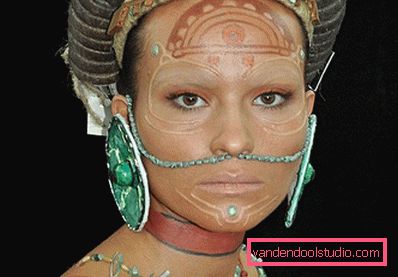
Skin scarification or scarification is a rather cruel kind of decoration of your body. Along with all the other decorations of our own body, the scarification came to us from antiquity, having changed in the technique of execution and its meaning. In antiquity, the procedure was a kind of ritual insignia and the scars were worn exclusively by warriors. After many centuries, scarification or stigmatization used to identify the criminal, having reached our time, the meaning of the procedure changed and many men and women covered their bodies with scars, gaining inner freedom and expressing their Self. Let's see how they make a scar and what is the beauty and the danger of this wearable decoration.
Repeat a little, scarification is a special application of scars on the body, representing in its finished form any pattern or pattern. Scarification tattoo has several techniques for applying scars:
- A simple, ordinary scar is made perpendicular to the surface, only the depth of the skin cut with a scalpel changes, resulting in an elegant and subtle pattern.
- A convex scar is obtained as a result of an incision under the slope, the result of such an execution becomes a voluminous, convex pattern.
- A concave scar, it is obtained in the process of removing a layer of skin with a scalpel, drawing, in this case, is obtained as a depression on the body.
Scarification is a rather painful procedure, most often it is done under local anesthesia. Only an experienced specialist using a sterile medical instrument will be able to competently perform tattooing scarring, since in fact this procedure is a small surgical operation.
Types of scarification
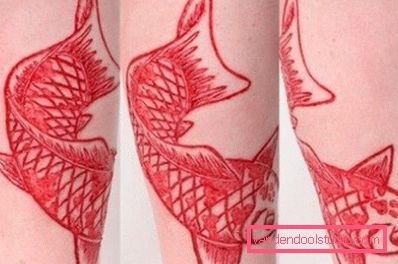
Scarification or scarification of the body can take place using different methods, one of the methods more reminiscent of branding the body to obtain a beautiful patterned scar. Another method has to cut on the body of the picture. Each of these variations has its own subspecies; we will describe all these species below.
Branding - burning, branding
- Strike Branding is a single cautery procedure, the pattern is made up of lines applied separately. Spraying the back is suitable for the branding strike as well as possible. The method is quite painful, but not long in time, unlike cutting with a scalpel.
- Cautery Branding- Scarification using special forms.
- Laser Branding - the application of the pattern occurs with a laser, the beam emitted by the laser creates an ignition effect.
- Cold branding is the opposite process of burning, the pattern on the body is applied with an object with a very low temperature, one can say with extreme. The tool is treated with liquid nitrogen.
Cutting - cutting with a scalpel
- Skin Removal - removes skin. This procedure is very popular, because after it the pattern has a clear outline. You can also cut through small parts, for the accuracy of the appearance of the picture.
- Packing is a popular procedure in the West, its roots come from Africa, where the procedure was of a ritual nature. Packing is rubbing ash into the cut or even the dust of a loved one. After such an event, in the process of healing, the body rejects the rubbed substance and a keloid scar forms at the site of the incision. This method is popular when getting a picture on the wrist.
It is also worth recalling that the volume and type of image depend on the angle of inclination of the scalpel. With perpendicular inclination, the scar will turn out bright and tender. And an incision made at an angle will be convex, but if you want a concave pattern, the master will have to cut the strips of skin depending on the width and type of the pattern. Sometimes, when performing the scarring, technologies can mix, so one can get a three-dimensional and detailed image.
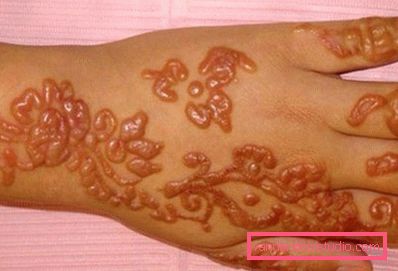
Scarification at home or in the cabin?
The price of scarring among professionals may exceed the cost of a tattoo. Depending on the size, sketch and complexity of the figure, prices range from 100 y. e. and up to 1000. But, when the price is inaccessible for many, some young people prefer to make a scar at home. This is where the main danger lies, since this procedure requires the provision of special conditions, knowledge in the field of medicine and surgery, as well as special sterile instruments. By doing the scarification of the body at home, you lose all these conditions, and no one will give you guarantees that all norms and professionalism will be observed, which can be fraught with unnecessary consequences. If you still decide to apply cuts to your body, then you need to learn a few basic recommendations.
Scarification with your own hands- recommendations
- First of all, it is necessary to refuse to do very complicated scarification operations in technological execution, such as deep cuts and volumetric scarring.
- Observance of the inclination angle of the cutting tool during the operation, otherwise you may get an uneven pattern. That is, for those who have never held a scalpel in their hands, it will be very difficult to achieve a good result.
- You should also choose the right places for scarring on your body. Scarification is done where there are no bends, or vessels are located close (elbows, knees, inner side of the thigh). Most often, scars are applied to the forearm, lower leg, hands and forehead.
- The simplest operation you can do at home is scraping or scratching. The desired pattern is obtained by gradual removal of the upper layers of the skin with a needle or scalpel. But one should not go deeper, as there is a danger to hook the muscles or the nerve.
- You can perform at home another method of applying scars - stamping. The scheme of the future pattern is made of medical wire in the form of a stigma, which is then heated on the fire and applied to the allotted skin area, it turns out a banal burn. After a while, the skin will heal and leave a scar at the site of the application.
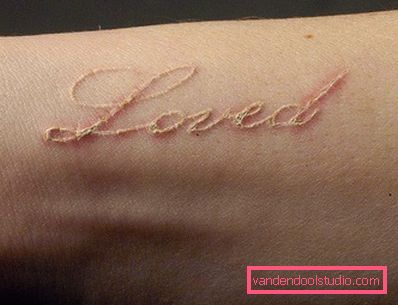
Scarification at home - instructions for execution
What do you need:
- Antiseptic is necessary for processing the material, tools and places of drawing.
- Sterile wipes will be needed during surgery.
- Medical scalpel, you can use a needle or a blade as a tool. But, only the surgical scalpel can be considered the most ideal tool. Firstly, it is hard, does not bend and does not slip during the operation, secondly, it is made of a special metal unlike a razor, which cannot lead to a cut or distortion of the pattern.
- Disposable gloves, before the operation, they must be treated with an antibacterial agent.
- Sketch of a drawing, most often use a decal.
How to do step by step:
- Anesthetic is injected under the skin. We draw your attention: it is under the skin, and not spraying an anesthetic. If you want to use a freeze, then swelling of the skin is possible and the pattern will blur. As a result, you will not get the expected result, which was planned at the beginning.
- Apply the markup to the skin, or apply a pattern with an easy to read and not complicated pattern. Then, carefully cut out a part of the skin with a scalpel, cutting off and lifting, thereby leaving the body part bare. Sterile wipes thoroughly soak up the exposed areas. In the future, the open parts of the skin will heal and turn into a beautiful scar, which with its contours will resemble your favorite pattern.
- After the operation is completed, apply a sterile dressing on the wound for 3 - 4 hours, then remove it. It is advisable to treat the skin with iodine or brilliant green near the applied pattern.
Care after body scarification

After scarification, the master should describe the care of the scar for you and be sure to set the date of the next visit in order to control the healing process. 3-4 hours after the procedure it is necessary to remove the protective bandage placed by the master, if there are bruises, let the blood come out and form a protective film. Treat with alcohol, iodine, brilliant green only around the scar, without affecting the scar itself. After a few days, the resulting blood film must be removed in order to cause the active formation of scar tissue, since the purpose of scarring is to expose the scar above the surface of the skin.
Is it worth doing scarification? Consequences of scarring
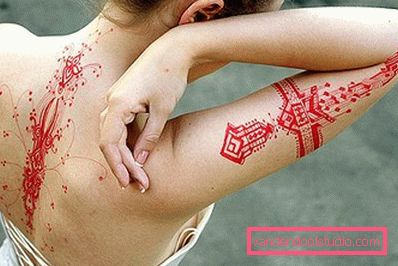
- In this procedure, anesthesia is very important; before submitting it, the master must ask about the presence of an allergy to the components of anesthetic preparations.
- After that, you can begin to select the desired sketch. When choosing a zone of scarification, it is necessary to avoid places where important blood vessels are located close to the skin. This is also a confirmation of the need to conduct the procedure not at home, as having touched a vein or artery, it is possible to say goodbye to life.
- Scarification has no specific healing time, this process depends on many things. One of the first moments is the area of the pattern made, the second moment is the way the procedure was carried out and of course your body's ability to tighten wounds.
- During healing it is necessary to ensure sterility, since the main negative consequence may be the penetration of infection into the wound.
- There is still an opportunity to experience painful shock, and an anaphylactic shock may occur from anesthesia obtained during the procedure.
- And one more thing, if you have previously noticed the formation of keloid scars, then now you can not avoid them.
- It is necessary to realize that the result obtained from scarring remains with you for the rest of your life. Get rid of this is no longer possible. It is better to spend a little time on viewing photos, which depicts the scarification before and after, viewing these images may help you choose the right path.
- What if, during the operation, under a strange name that makes any normal person start up with a name — a scarification on his face, something goes wrong? You can disfigure your appearance so that your own mother will not recognize you.
- Since changes occur in the body with age, it becomes thin, possibly flabby, or, on the contrary, gains kilograms, all of this will directly affect the pattern obtained during the scarring, which can turn into a terrifying scar.
- It is also necessary to think about the loss of blood during the procedure and the possibility of contracting dangerous hepatitis viruses, HIV or another terrible disease from a poorly sterilized instrument. If the master doing this procedure was mistaken in some moments, then there is a risk to get blood poisoning, gangrene and the option to say goodbye to life in general.
Contraindications to the procedure
- The presence of diseases such as HIV, hepatitis, syphilis, diabetes mellitus or an enlarged thyroid gland.
- If you have observed the formation of keloid scars, fungal skin diseases or pustular formations, with psoriasis.
- Before the procedure, or rather the day, a person should not take any blood thinning medication and drink alcohol.